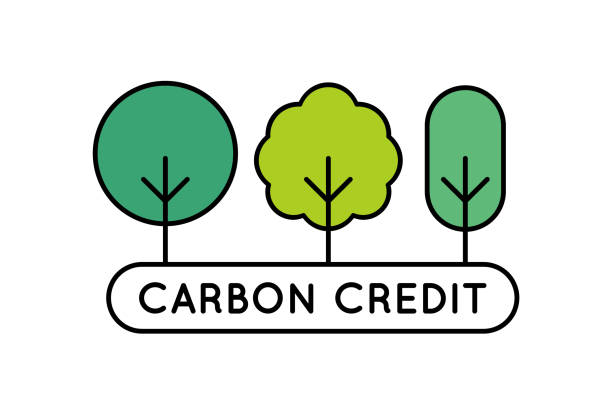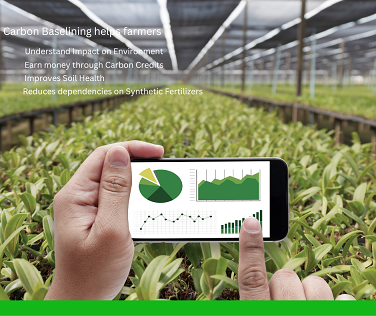Contact: +91 99725 24322 |
Menu
Menu
Quick summary: Learn about the importance of carbon baselining in agriculture and how it can help measure and reduce greenhouse gas emissions. Explore methods, tools, and best practices for accurately assessing carbon footprints in agricultural systems and promoting sustainable farming practices. Discover how carbon baselining can contribute to climate change mitigation and the creation of more resilient and environmentally friendly agricultural systems.

Carbon baselining is the process of measuring and quantifying the amount of carbon that is stored in the soil, plants, and other organic matter on a farm. In agriculture, this process involves measuring the carbon stocks of a farm to establish a baseline or starting point for carbon management.
The goal of carbon baselining is to understand the farm’s impact on the environment and identify ways to reduce greenhouse gas emissions. By measuring the amount of carbon stored in the soil and plants, farmers can determine how their farming practices are affecting the carbon cycle. This information can be used to identify areas where farmers can implement practices that reduce greenhouse gas emissions or sequester carbon, which can help mitigate climate change.
Carbon baselining is important in agriculture because it provides farmers with valuable information about their impact on the environment, can help them earn money, improve soil health, reduce reliance on synthetic inputs, and mitigate climate change.
According to CDP, companies in the agriculture sector that implemented carbon baselining and reduction strategies achieved an average emission reduction of 23% over a five-year period.
It helps farmers understand their impact on the environment: Carbon baselining provides farmers with valuable information about their greenhouse gas emissions and their overall impact on the environment. By measuring their carbon footprint,

Accurate data collection and analysis are crucial for carbon baselining, as it is the foundation for measuring and managing greenhouse gas emissions. Here are a few reasons why accurate data collection and analysis are so important in carbon baselining:
Accurate data collection and analysis are essential for carbon baselining to provide meaningful information for measuring, managing, and reducing greenhouse gas emissions. By ensuring credibility, identifying areas for improvement, developing effective abatement strategies, achieving sustainability goals, and facilitating decision-making, accurate data can help organizations to become more sustainable and reduce their impact on the environment.
To start the process of carbon baselining, farmers need to collect data on their farm’s carbon stocks. This can include measuring soil organic matter, plant biomass, and the carbon stored in livestock and farm equipment. Once this data has been collected, it can be used to calculate the farm’s carbon footprint.
Farmers can then use this information to identify areas where they can reduce their carbon footprint. For example, they may decide to implement conservation tillage practices, which can help to increase soil organic matter and reduce carbon emissions. They may also choose to use cover crops, which can help to sequester carbon in the soil.
Another important aspect of carbon baselining is the use of carbon credits. Carbon credits are a way for farmers to earn money by reducing their carbon footprint. Farmers can earn carbon credits by implementing sustainable farming practices that reduce emissions or sequester carbon. These credits can then be sold to companies or governments looking to offset their own emissions.
In addition to reducing greenhouse gas emissions, carbon baselining can also have other benefits for farmers. For example, increasing soil organic matter can improve soil health and fertility, which can lead to increased crop yields and reduced reliance on synthetic fertilizers and pesticides.
Carbon baselining is an important tool for farmers who are looking to reduce their carbon footprint and adopt more sustainable farming practices. By measuring their carbon stocks and taking steps to reduce emissions, farmers can help to mitigate climate change and improve the health of their farms and communities.
Trace Carbon is a one-stop carbon management platform that can be used to help with carbon baselining in agriculture. The platform is designed to capture granular level carbon emissions data for a product or farm from production to consumption and end of cycle. This data can then be used to assess carbon hotspots and develop abatement strategies to reduce greenhouse gas emissions.
In the context of agriculture, the Trace Carbon platform can help to measure the impact of sustainable farming practices and generate reports to fulfill sustainability commitments and achieve sustainable development goals. For example, the platform can be used to measure the carbon footprint of a farm, identify areas of high emissions, and develop strategies to reduce greenhouse gas emissions and improve soil health. The platform also enables measurement and monitoring of sustainability metrics like soil health, biodiversity, water health and farmer livelihoods.
Trace Carbon uses a combination of remote sensing data, field measurements, and modeling to estimate greenhouse gas emissions and carbon sequestration. It provides seamless integration with IoT devices and remote sensing equipment. The platform can also track the carbon footprint of products throughout their life cycle, from production to consumption and disposal.
Carbon baselining is an essential practice in agriculture as it helps farmers and agribusinesses to identify, measure and manage their carbon footprint. By conducting a baseline assessment, farmers can identify their sources of emissions, including energy use, fertilizer application, and livestock management, and quantify their greenhouse gas emissions. This information can then be used to develop effective strategies to reduce emissions, improve sustainability, and achieve climate-related goals. Accurate data collection and analysis are crucial for carbon baselining in agriculture, as it enables farmers to measure their progress towards reducing their carbon footprint and identify areas for improvement. Overall, carbon baselining helps farmers to become more sustainable, reduce their environmental impact, and contribute to the global effort to address climate change.
